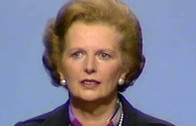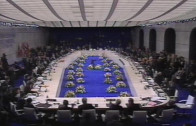The Mayfair Set
The Mayfair Set is a four part series that studies how capitalists overtly and surreptitiously came to prolifically shape governments during the 1980s, epitomised by the Thatcher government in Britain at the time. But the corporate influence of political power doesn’t simply arrive, it rather culminates after decades of engineering rooted in the economic collapse from the aftermath of the Second World War. This series focuses on the unreported and almost unseen approach that capitalists have taken since the 1940s to gradually take control of the political systems of not only the United States and Britain, but elsewhere around the world—exemplified by the boom of globalisation.
Series
The first part of the series examines how the British establishment turned to global arms dealing to sustain its economy after it saw the dwindling of its post-war empire. Also examined is how key business interests aligned to usurp and control political outcomes in Yemen and elsewhere in the Middle East to suit the economic circumstances in Britain–early examples of Plausible Deniability and covert operations. The story touches on The Clermont Club, one of the first London casinos, where businessmen such as James Goldsmith, Gianni Agnelli, Jim Slater, and Kerry Packer would meet with political figures, lords and dukes–very similar to the modern-day Bilderberg Group–presumably to discuss such matters and align interests.
Citing the example of an accountant named Jim Slater in the 1960s, this episode looks at the beginnings of how capitalists turned to predictive analysis to control the stock market, with great success, in turn burgeoning the idea and propagating it throughout the economy as a means of extending control not only over industry and finance, but over political systems too. Slater was one of the first in Britain to pioneer the corporate hostile takeover, a model which would become popularised with the capitalists to centralise and concentrate wealth and control in the years to come.
Turning to the United States, the story continues with the rise of Ronald Regan and the ushering in of the era of ‘The Markets.’ We see the introduction of the prevalence of bonds, rooted in the current day cycles of boom and bust. One example used to illustrate this is the junk bonds that funded the creation of casinos throughout Las Vegas which in turn fuelled prolific centralisation of wealth and the rewarding of greed with risk. This is also later explained with the interfacing of junk bonds with superannuation and pension funds. The story also pivots around James Goldsmith, a ‘financier’ and tycoon, and how he became one of the richest men in the world; also showing the elements of the use of the hostile takeover and the euphemism, “downsizing.”
The era of ‘The Market’ had ushered in massive centralisation of wealth and political power. But as some of the capitalists are marginalised by the very forces they had unleashed, they seek to reassert themselves elsewhere. At the same time, Britain and other countries opened up their economies to the international market. They floated their currencies and removed exchange restrictions. This caused the political forces to become further marginalised too, and both groups would become more subservient to the economic system–and the increasingly smaller group of bankers and money managers wielding more power and the return of ever larger profits–more than ever before. This final episode also shows how political institutions were turned into businesses by these happenings, with the examples of lobbying, PR, and bribery.




